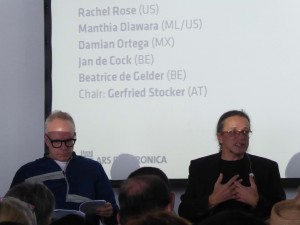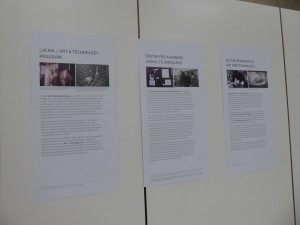Ars Electronica 2017 is not big, it is massive. Now I understand why people just post pictures : although I had made a strict selection in the threads I wanted to follow, it is impossible not only to see everything but to make some kind of overall analysis.
So, let’s go with fragments.
Gluon Session : Art-Science goes contemporary art
The Belgium Gluon Foundation is proposing a « new model for cooperation among artists, scientists and art collectors » by reversing the process and « having scientists in residence in the ateliers of top-name artists ».
Gluon organised a panel with Hans Ulrich Obrist, Paul Dujardin from Bozar in Bruxelles and the artists, which remained a bit basic in the thinking about art-science.

Hans-Ulrich Obrist and Gerfried Stocker during the Gluon Session at Ars Electronica 2017. Image Annick Bureaud
The selection of the artists is a curatorial decision, which is fine. I could not figure out how the scientists were selected. Apparently, the « matching » process during which the artists and scientists were paired was done here at Ars Electronica, and it seems it followed the FEAT model in which the scientists « pitch » their research field to the artists that then « pick up » with whom they want to collaborate.
How does an « artist atelier » looks like nowaday ? Some artists still have studios but many others just need a room with a computer and others definitively need a professional research lab. This question was raised during the panel and left open for the moment.
In the booth presenting their project in the exhibition, Gluon referenced the « historical » projects such as CAVS and LACMA, but nothing since the « good old days ».
I hope to learn more when I get the brochure Gluon published about the projec


 Follow
Follow